|
How To Test Your Software To Avoid Technical Glitches

During the SEC's market technology roundtable, GETCO CTO Jonathan Ross argued that market participants must follow several testing best practices to avoid technical glitches.
read more... |
The Future of human/ Electronic skin technology
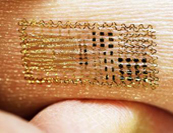
Merging biology and electronics gives access to a new and upcoming technology. This has led to the development of a super thin and highly flexible material like a tattoo, embedded with a wireless electronic chip to be stuck on human skin.
read more...
|
|
|
New radar technology helps see through walls
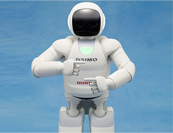
Researchers at MIT’s Lincoln Laboratory have devised a new mechanism that allows to spot activities on the other side of the solid wall obstruction, something which was more of a sci-fi phenomenon until now.
We can see our environment, spot objects and activities because of the light reflecting from them back to our eyes/ retinas. This is one of the scientific factors that make our ‘visual experiences’ possible. If the light is reflecting from a solid wall, we can only visually experience the ‘wall’ and not the environment behind that is being obstructed. Now, what we are talking about is called ‘visible light’; which doesn’t really help in seeing through obstructions.
read more... |
|
|
A Bright Future for EHRs, but When?
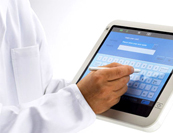
A broad consensus exists about the future viability of electronic health records, yet there remains a good deal of dissension over when and how that future arrives. Indeed, recent polling conducted by Health Data Management bears this out, with nearly equal numbers of respondents predicting either rapid or gradual growth of EHRs.
read more...
|
Welcome to the world of Handwriting Analysis

We all know that every human is different from another; similarly, their handwritings are also unique. Graphology or handwriting analysis is the process of analysis of the physical character and pattern of writing claiming to be able to recognize the writer, representing psychosomatic condition at the occasion of writing, or evaluating individuality character.
read more...
|
| |
|
Detailed Articles |
|
How To Test Your Software To Avoid Technical Glitches
Watch Wall Street & Technology and Advanced Trading's on-demand video analysis of the SEC's market technology roundtable: here.
The technical errors that have recently befallen Knight Capital, BATS and Nasdaq causing chaos to the markets are not the result of complexity or fragmented markets, but the result of basic technology 101 issues, SEC chairperson Mary Schapiro said today during the agency's market technology roundtable.

During the SEC discussion, Dr Nancy Leveson, professor of aeronautics and astronautics and engineering systems, MIT, argued that software errors will always happen. The financial industry, like the aviation industry, needs solutions beyond technology – which must include strong regulation. " Most industries have government agencies overseeing with an iron hand.
The aircraft industry knows people will stop flying if planes start falling out of the sky. You cannot build an unsinkable ship or unfailable software. If you engage in hubris and wishful thinking, you will have to suffer the consequences," Leveson said.
Still, GETCO CTO Jonathan Ross argued that in order to avoid technical glitches, firms must follow several testing best practices: These include having independently designed systems, he said.
"To the extent possible, systems should be independent from other systems to limit the potential for an error or failure to cascade to other systems," he said, adding that any changes to systems must be small, incremental and frequent to reduce the magnitude of any errors and make it easier to mitigate the impact of such errors if they do occur.
Ross also suggested using layered, redundant risk measures, with multiple, overlapping levels of preventive or protective risk controls that each look at a system independently.
GETCO has a formal process for testing its software, Ross noted. This includes a testing lab, testing protocols that developers follow, and change management processes, he wrote in a statement for the SEC.
"Development and testing should reinforce each other; continuous building and testing gives developers a strong feedback loop," he said. In the development cycle, common approaches to software testing firms should follow include unit testing – or tests of discrete, generally small, specific and functional, components of the system.
Best practices should also include regression testing, or tests built specifically to address a bug previously identified and to prevent the reintroduction of that bug and integration testing, or system tests designed to test the interaction of applications with each other or outside parties.
Article Source
|
|
|
The Future of human/ Electronic skin technology
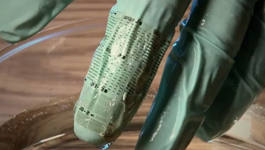
Merging biology and electronics gives access to a new and upcoming technology. This has led to the development of a super thin and highly flexible material like a tattoo, embedded with a wireless electronic chip to be stuck on human skin. It’s applications are many, from monitoring health to even sending commands to human-machine interfaces like video games. The newly developed material/device is easily removable, as easily it’s stuck on the skin surface.
The device is designed to easily blend in with the mechanics of the human skin, where it can resist the natural vigor of twists, turns and stretches of the human skin, yet maintaining the functionality of the wireless circuitry. The research is being led by John A. Rogers, the Lee J. Flory-Founder professor of engineering at the University of Illinois.
A number of technological challenges must be surmounted before EHRs are widely adopted, Schubert says. "Today's average interaction by a health services consumer still involves a 19th century paperwork trail, and that drives costs up, efficiencies down, and improper diagnosis and treatment," he says. "There are major challenges, though, that will need to be overcome such as universal data taxonomy, ease-of-use for the consumers and providers, personal information safeguards, and checks-and-balances to ensure that the data is good and remains good."
“The vision is to exploit these concepts in systems that have self-contained, integrated functionality, perhaps ultimately working in a therapeutic fashion with closed feedback control based on integrated sensors, in a coordinated manner with the body itself,” Rogers said.
Article Source
|
|
|
New radar technology helps see through walls
Researchers at MIT’s Lincoln Laboratory have devised a new mechanism that allows to spot activities on the other side of the solid wall obstruction, something which was more of a sci-fi phenomenon until now.
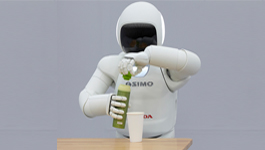
We can see our environment, spot objects and activities because of the light reflecting from them back to our eyes/ retinas. This is one of the scientific factors that make our ‘visual experiences’ possible. If the light is reflecting from a solid wall, we can only visually experience the ‘wall’ and not the environment behind that is being obstructed. Now, what we are talking about is called ‘visible light’; which doesn’t really help in seeing through obstructions.
John Peabody and Gregory Charvat at Lincoln Laboratory have tested an idea that uses radio waves instead of visible light to see through walls. The emitted radar signals pass through the concrete walls and deflect back to the radar receivers easily, with some signals losses in transit. The signal losses aren’t a problem because of the availability of affordable signal amplifying devices.
Article Source |
|
|
A Bright Future for EHRs, but When?
A broad consensus exists about the future viability of electronic health records, yet there remains a good deal of dissension over when and how that future arrives. Indeed, recent polling conducted by Health Data Management bears this out, with nearly equal numbers of respondents predicting either rapid or gradual growth of EHRs. The online polls, with a total of 83 respondents, were conducted as part of a December 2009 (two weeks before the interim meaningful use rules were issued) Health Data Management Webcast, "The Future of Digital Health."
Karl D. Schubert, managing partner and chief technology officer of Minnetonka, Minn.-based TechNova Consulting, falls in the latter camp of expecting a gradual expansion of EHRs. In one of a series of interviews conducted with Webcast participants after the event, he compared the adoption curve with how banks rolled out ATMs. "The future for digital health is bright, but it is not going to happen overnight. It will not be easy, and we will have to invest money to save money and improve health care in the long run."
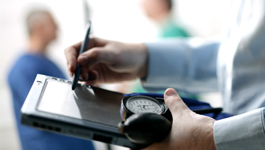
A number of technological challenges must be surmounted before EHRs are widely adopted, Schubert says. "Today's average interaction by a health services consumer still involves a 19th century paperwork trail, and that drives costs up, efficiencies down, and improper diagnosis and treatment," he says. "There are major challenges, though, that will need to be overcome such as universal data taxonomy, ease-of-use for the consumers and providers, personal information safeguards, and checks-and-balances to ensure that the data is good and remains good."
Another source of division among survey respondents was the impact of the spending stipulated under the American Recovery and Reinvestment Act of 2009 to encourage meaningful EHR adoption (see cover story, page 40). Opinions split almost evenly among those who think federal spending will spur adoption and those who say it is too soon to tell. Twelve percent of survey respondents dismissed the stimulus efforts as a boondoggle.
Brett Harnett, research assistant professor and chief, division of I.T. at the University of Cincinnati Dept. of Surgery, says the federal push will catalyze EHR adoption. Like many other respondents, he likens the program to a mandate. Although the program does not specifically require an EHR, it does eventually penalize those without one by reducing their government reimbursements. "The government has taken a two-pronged approach to the adoption of EHRs," he says. "First by mandating it and second by incentivizing it. Although there are issues to resolve such as interoperability and unique patient identification numbers, the incentive represents a financial 'carrot' that should be embraced by providers."
Donna DuLong, a consultant at Ridgefield, Conn.-based Apelon Inc., medical terminology management software provider, agrees the stimulus will speed EHRs along the path toward widespread use. "The federal I.T. stimulus program will not only raise awareness for the need to adopt EHRs, but more importantly, fuel the debate about how EHRs need to improve our ability to deliver higher quality patient care," she says.
Erin Stevenson, a digital health care consultant at Redwood Medical Consulting, Bayside, Calif., says EHRs' ability to improve outcomes for doctors and patients will spur adoption. "There are still bumps in the road, but inevitably patients win from better and more timely and targeted treatment, potentially earlier intervention and treatment of life-altering health conditions. Doctors can improve their quality of service and bottom line, decrease mistakes, expand their patient base and have access to advanced decision support resources."
Article Source
|
|
|
Welcome to the world of Handwriting Analysis
We all know that every human is different from another; similarly, their handwritings are also unique. Graphology or handwriting analysis is the process of analysis of the physical character and pattern of writing claiming to be able to recognize the writer, representing psychosomatic condition at the occasion of writing, or evaluating individuality character.
Why we should use Graphology?
Hand writing analysis completely saves your time in finding many things about a person like emotions, character, strengths, weakness, desires etc. You can easily know about what is running in a person's mind with the help of Handwriting. So to know about a person and yourself Graphology is used.
You can also use this technique for analysing about yourself and make changes in you for better attitude and behaviour.
How is Handwriting analysis or graphology work?
When you write something on the paper, your complete character gets stamped on it. Some of the major things about your personality can be analyzed by looking at the size of the alphabet, spacing, slant, height, pressure, width etc.
When we begin to write our brain send message to our hand to shape the strokes that can expose what we think, how we think, what we like, dislike, how we behave etc. The thoughts in our mind can easily get impact on our handwriting.
The only thing that we cannot predict in hand writing analysis is the future of a person.
Some of the top Uses of Handwriting Analysis are:
Graphology can help you to understand about yourselves:
Having precise methods for revealing and understanding fundamental character and identity qualities have many favourable uses; knowing you is not the minimum of them. Graphology report can enable you to pick up bits of knowledge into your own qualities. What's more, however you may need to confront some repulsive certainties, it will at any rate empower you to settle on more perceptive choices for your own and expert life.
Graphology can help you to understand about other people:
We all know that to understand a people it will take huge amount of time, but if you use graphology by understanding their handwriting, you can get to know their behaviour, attitude etc, which helps you to know what is their expectations, approach etc.
Graphology can help you to choose a write person for write carier:
Nowadays in all the organizations handwriting analysis is used to choose a particular candidate for the process of selection, recruitment, team building etc, because it is a unique indicator of personality.
Graphology is used to solve criminal cases:
We all know that handwriting analysis is used in forensic laboratories to find the actual criminal, because as we mentioned earlier with the help of a person’s handwriting you can know how his brain works.
Graphology is used to solve compatibility of couples:
By Handwriting analysis, we can easily deal with emotional and psychological issues which helps to determine the compatibility of the couples and helping them to understand themselves.
Graphology can be a carrier:
If you become master in this field then you can get huge job opportunities in various departments like police, business, hospitals, mental health care hospitals etc. If you are interested then you can be an independent handwriting consultant and help many people.
|
|
Itech Solutions |
|












